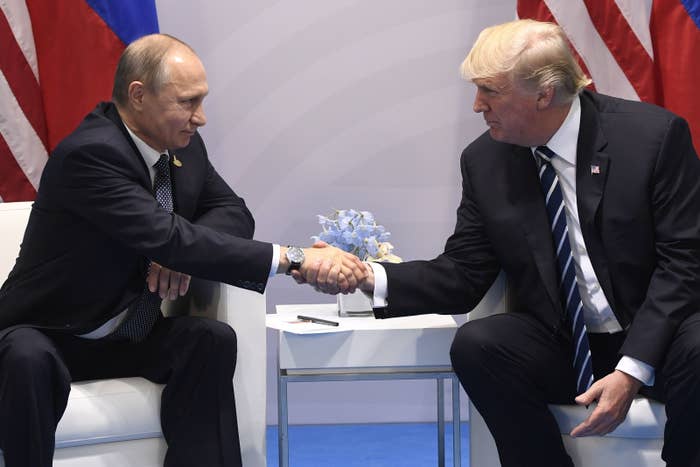The US military has received no guidance on how to enforce the ceasefire now in place in southwest Syria, even as the Trump administration hails it as a success, three Defense Department officials told BuzzFeed News on Monday.
US military officials said they don’t have any formal role in the ceasefire, or in monitoring or enforcing it in any way. It is unclear whether the US military is collecting intelligence in the area that might be useful in highlighting violations.
“You’d think we would be a part of it,” one US military official explained.
The lack of US involvement in monitoring the ceasefire raises questions about how effective the deal will be, and who precisely is enforcing it. Officials were apparently still ironing out the details even after the deal went into effect on Sunday.

On Monday, Russian Foreign Minister Sergey Lavrov announced that the signatories to the deal — the US, Russia, and Jordan — had agreed to create a monitoring center for southwest Syria that would be based in the Jordanian capital Amman.
The State Department, which took the lead in negotiating the ceasefire, denied that the Pentagon was left out of the loop. The "Defense Department, and other related agencies have been directly involved in the negotiation of the southwest Syria ceasefire," State Department spokesman Edgar Vasquez told BuzzFeed News.
"We maintain a full interagency team dedicated to these ceasefire arrangement elements," he added.
However, the State Department could not confirm Lavrov's statement regarding the creation of a monitoring center and said such details were still being hammered out.
President Trump had already celebrated the agreement in a tweet on Sunday, saying it “seems to be holding” and that it was the product of his talks with Russian President Vladimir Putin on the sidelines of the G20 summit in Hamburg, Germany, on Friday.
Syrian ceasefire seems to be holding. Many lives can be saved. Came out of meeting. Good!
Yet, just east of one province covered by the agreement and west of where US-backed troops are located, Syrian forces, backed by Russian airpower, reportedly attacked opposition forces on Monday. It — literally — bordered on defiance of the agreement.
In announcing the agreement last week, Lavrov said that the US and Russia "promised to ensure that all groups there comply with the ceasefire." But the precise role of the US military is unclear in the deal, which calls for an end to fighting in what Secretary of State Rex Tillerson called a “de-escalation zone” in three Syrian provinces — Deraa, Suweida, and Quneitra.
Southwest Syria hasn’t been a US military priority because few ISIS forces operate there. According to a review of daily US Central Command statements on military actions against ISIS, there have been no US coalition airstrikes in the area in the last month. Throughout the nearly three-year US-led air campaign against ISIS, airstrikes in southwest Syria have only been sporadic.
Instead, the area is dominated by forces loyal to Syrian President Bashar al-Assad and opposition groups, many of whom — including the al-Qaeda-affiliated group formerly known as the Nusra Front — are not backed by the US. Neither the government nor anti-Assad rebel groups are signatories to the ceasefire.
The ISIS forces that are believed to be in the area have recently consolidated their positions in southwestern Deraa province, near where the borders of Syria, Jordan, and Israel meet. In February, the Jordanians confirmed they had conducted cross-border strikes in that area.
US military officials said the best explanation for their not having been looped into the ceasefire agreement was the speed with which it came together. “This was quickly negotiated by the diplomatic community,” said one Pentagon official.
Over the weekend, Jordan's Minister of State for Media Affairs Mohammad Momani suggested that the agreement would stop fighting along the border, and that it is monitoring the agreement, according to a state media report. The Jordanians also said the deal called for resumed access to humanitarian aid.
But officials have struggled to spell out the details. A State Department senior official, who was involved in reaching the agreement and who briefed reporters on Friday, said that there were still enforcement details to be worked out — even as the deal was set to go into effect.
“The US likely has two main goals with this ceasefire. This first is to test Russia’s intent and possible capability to adhere to a ceasefire,” said Jennifer Cafarella, a Syria analyst at the Washington-based Institute for the Study of War. “The second is to incentivize US-backed rebels in the south to refocus on ISIS in the south, along the Golan Heights.”
The Syrian Observatory for Human Rights said there has been only light military activity in the three affected provinces since the ceasefire took effect at noon on Sunday.
The ceasefire is the latest of at least five ceasefires to have been declared in the six-year war, all of which unraveled — at times because of the lack of an enforcement mechanism. A so-called cessation of hostilities is in place in other parts of Syria, though that agreement doesn’t apply to groups the Russians and Syrians deem to be al-Qaeda affiliates. In the past, the US military has publicly discussed ways to enforce such agreements.
US National Security Adviser H.R. McMaster told reporters aboard the president’s plane returning from the G20 on Saturday that the agreement was the first step in ending the war in Syria — but didn’t explain why such efforts should begin in that part of Syria. He called it “the very beginning” of an attempt to stabilize “a portion of Syria” in search of “enduring political settlements.” But he said the US goal remains defeating ISIS and other terror groups, and not resolving Syria’s civil war.
John Hudson contributed to this report.

